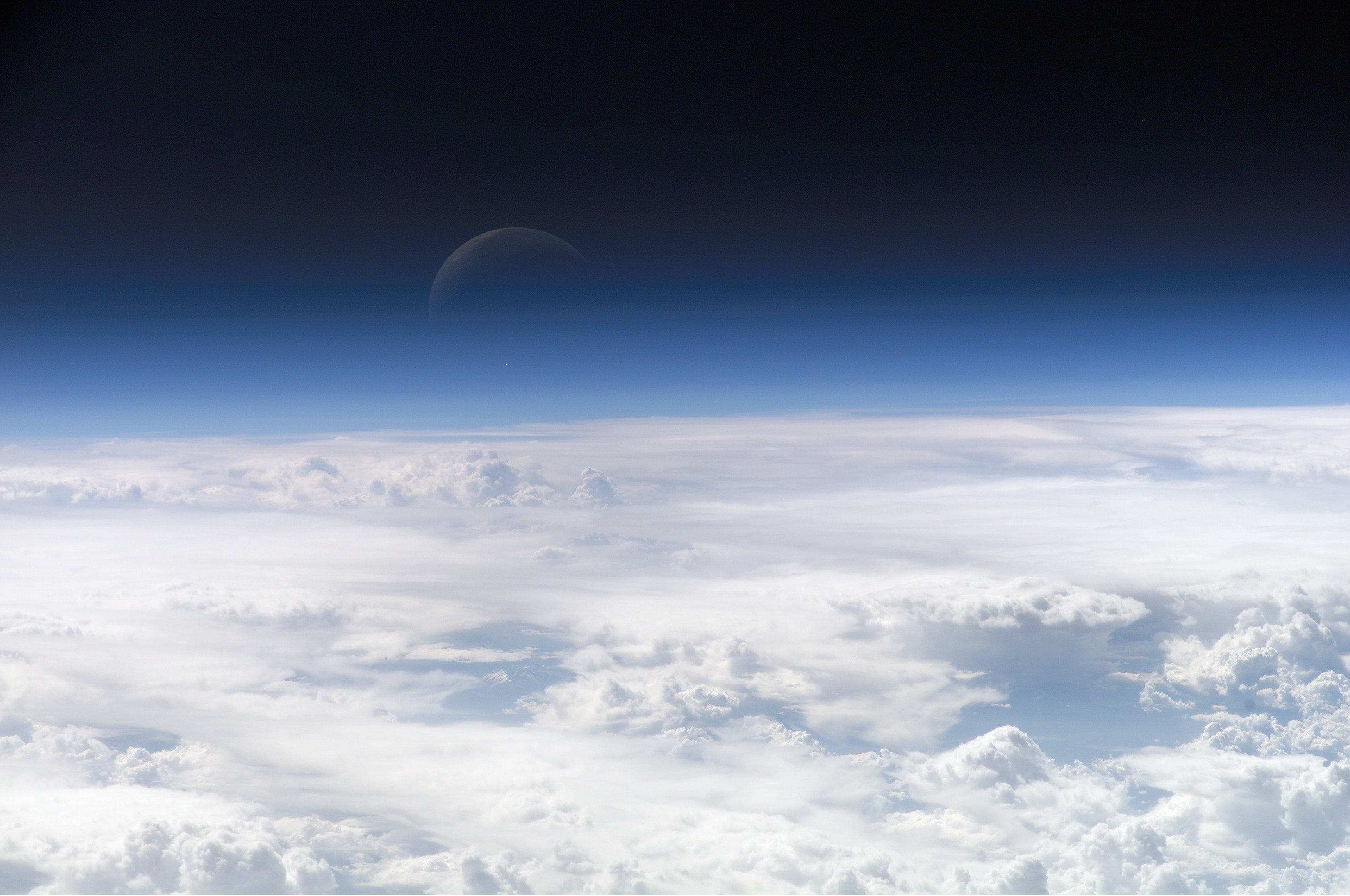|
Thermosphere
The thermosphere is the layer in the Earth's atmosphere directly above the mesosphere and below the exosphere. Within this layer of the atmosphere, ultraviolet radiation causes photoionization/photodissociation of molecules, creating ions; the thermosphere thus constitutes the larger part of the ionosphere. Taking its name from the Greek language, Greek θερμός (pronounced ''thermos'') meaning heat, the thermosphere begins at about 80 km (50 mi) above sea level. At these high altitudes, the residual atmospheric gases sort into strata according to molecular mass (see turbosphere). Thermospheric temperatures increase with altitude due to absorption of highly energetic solar radiation. Temperatures are highly dependent on solar activity, and can rise to or more. Radiation causes the atmospheric particles in this layer to become electrically charged, enabling radio waves to be refracted and thus be received beyond the horizon. In the exosphere, beginning at about 600&nb ... [...More Info...] [...Related Items...] OR: [Wikipedia] [Google] [Baidu] |
Earth's Atmosphere
The atmosphere of Earth is the layer of gases, known collectively as air, retained by Earth's gravity that surrounds the planet and forms its planetary atmosphere. The atmosphere of Earth protects life on Earth by creating pressure allowing for liquid water to exist on the Earth's surface, absorbing ultraviolet solar radiation, warming the surface through heat retention ( greenhouse effect), and reducing temperature extremes between day and night (the diurnal temperature variation). By mole fraction (i.e., by number of molecules), dry air contains 78.08% nitrogen, 20.95% oxygen, 0.93% argon, 0.04% Carbon dioxide in Earth's atmosphere, carbon dioxide, and small amounts of other gases. Air also contains a variable amount of Water vapor#Water vapor in Earth's atmosphere, water vapor, on average around 1% at sea level, and 0.4% over the entire atmosphere. Air composition, temperature, and atmospheric pressure vary with altitude. Within the atmosphere, air suitable for use in ... [...More Info...] [...Related Items...] OR: [Wikipedia] [Google] [Baidu] |
Ionosphere
The ionosphere () is the ionized part of the upper atmosphere of Earth, from about to above sea level, a region that includes the thermosphere and parts of the mesosphere and exosphere. The ionosphere is ionized by solar radiation. It plays an important role in atmospheric electricity and forms the inner edge of the magnetosphere. It has practical importance because, among other functions, it influences radio propagation to distant places on Earth. History of discovery As early as 1839, the German mathematician and physicist Carl Friedrich Gauss postulated that an electrically conducting region of the atmosphere could account for observed variations of Earth's magnetic field. Sixty years later, Guglielmo Marconi received the first trans-Atlantic radio signal on December 12, 1901, in St. John's, Newfoundland (now in Canada) using a kite-supported antenna for reception. The transmitting station in Poldhu, Cornwall, used a spark-gap transmitter to produce a signal with a f ... [...More Info...] [...Related Items...] OR: [Wikipedia] [Google] [Baidu] |
Mesopause
The mesopause is the point of minimum temperature at the boundary between the mesosphere and the thermosphere atmospheric regions. Due to the lack of solar heating and very strong radiative cooling from carbon dioxide, the mesosphere is the coldest region on Earth with temperatures as low as -100 °C (-148 °F or 173 K). The altitude of the mesopause for many years was assumed to be at around 85 km (53 mi), but observations to higher altitudes and modeling studies in the last 10 years have shown that in fact the mesopause consists of two minima - one at about 85 km and a stronger minimum at about 100 km (62 mi). Another feature is that the summer mesopause is cooler than the winter (sometimes referred to as the ''mesopause anomaly''). It is due to a summer-to-winter circulation giving rise to upwelling at the summer pole and downwelling at the winter pole. Air rising will expand and cool resulting in a cold summer mesopause and conversely downw ... [...More Info...] [...Related Items...] OR: [Wikipedia] [Google] [Baidu] |
Atmospheric Tide
Atmospheric tides are global-scale periodic oscillations of the atmosphere. In many ways they are analogous to ocean tides. Atmospheric tides can be excited by: *The regular day–night cycle in the Sun's heating of the atmosphere (insolation) *The gravitational field pull of the Moon *Non-linear interactions between tides and planetary waves. *Large-scale latent heat release due to deep convection in the tropics. General characteristics The largest-amplitude atmospheric tides are mostly generated in the troposphere and stratosphere when the atmosphere is periodically heated, as water vapor and ozone absorb solar radiation during the day. These tides propagate away from the source regions and ascend into the mesosphere and thermosphere. Atmospheric tides can be measured as regular fluctuations in wind, temperature, density and pressure. Although atmospheric tides share much in common with ocean tides they have two key distinguishing features: # Atmospheric tides are primaril ... [...More Info...] [...Related Items...] OR: [Wikipedia] [Google] [Baidu] |
Kármán Line
The Kármán line (or von Kármán line ) is an attempt to define a boundary between Earth's atmosphere and outer space, and offers a specific definition set by the Fédération aéronautique internationale (FAI), an international record-keeping body for aeronautics. Defining the edge of space is important for legal and regulatory purposes since aircraft and spacecraft fall under different jurisdictions and are subject to different treaties. International law does not define the edge of space, or the limit of national airspace. The FAI defines the Kármán line as space beginning above Earth's mean sea level. This number is well above the altitude reachable by a conventional airplane and is roughly where satellites, even on very eccentric trajectories, will decay before completing a single orbit. While experts disagree on exactly where the atmosphere ends and space begins, most regulatory agencies (including the United Nations) accept the FAI Kármán line definition or someth ... [...More Info...] [...Related Items...] OR: [Wikipedia] [Google] [Baidu] |
Diurnal Temperature Variation
In meteorology, diurnal temperature variation is the variation between a high air temperature and a low temperature that occurs during the same day. Temperature lag Temperature lag is an important factor in diurnal temperature variation: peak daily temperature generally occurs ''after'' noon, as air keeps net absorbing heat even after noon, and similarly minimum daily temperature generally occurs substantially after midnight, indeed occurring during early morning in the hour around dawn, since heat is lost all night long. The analogous annual phenomenon is seasonal lag. As solar energy strikes the Earth's surface each morning, a shallow layer of air directly above the ground is heated by conduction. Heat exchange between this shallow layer of warm air and the cooler air above is very inefficient. On a warm summer's day, for example, air temperatures may vary by from just above the ground to waist height. Incoming solar radiation exceeds outgoing heat energy for many hours af ... [...More Info...] [...Related Items...] OR: [Wikipedia] [Google] [Baidu] |
International Space Station
The International Space Station (ISS) is the largest Modular design, modular space station currently in low Earth orbit. It is a multinational collaborative project involving five participating space agencies: NASA (United States), Roscosmos (Russia), JAXA (Japan), European Space Agency, ESA (Europe), and Canadian Space Agency, CSA (Canada). The ownership and use of the space station is established by intergovernmental treaties and agreements. The station serves as a microgravity and space environment research laboratory in which Scientific research on the International Space Station, scientific research is conducted in astrobiology, astronomy, meteorology, physics, and other fields. The ISS is suited for testing the spacecraft systems and equipment required for possible future long-duration missions to the Moon and Mars. The International Space Station programme, ISS programme evolved from the Space Station Freedom, Space Station ''Freedom'', a 1984 American proposal to constr ... [...More Info...] [...Related Items...] OR: [Wikipedia] [Google] [Baidu] |
Tropopause
The tropopause is the atmospheric boundary that demarcates the troposphere from the stratosphere; which are two of the five layers of the atmosphere of Earth. The tropopause is a thermodynamic gradient-stratification layer, that marks the end of the troposphere, and lies approximately above the equatorial regions, and approximately above the polar regions. Definition Rising from the planetary surface of the Earth, the tropopause is the atmospheric level where the air ceases to become cool with increased altitude, and becomes dry, devoid of water vapor. The tropopause is the boundary that demarcates the troposphere from the stratosphere, and is the part of the atmosphere where there occurs an abrupt change in the environmental lapse rate (ELR), from a positive rate in the troposphere to a negative rate in the stratosphere. The ELR indicates the lowest level at which the lapse rate decreases to 2°C/km or less, provided that the average lapse-rate, between that level and all ot ... [...More Info...] [...Related Items...] OR: [Wikipedia] [Google] [Baidu] |
Atmosphere Layers-en
An atmosphere () is a layer of gas or layers of gases that envelop a planet, and is held in place by the gravity of the planetary body. A planet retains an atmosphere when the gravity is great and the temperature of the atmosphere is low. A stellar atmosphere is the outer region of a star, which includes the layers above the opacity (optics), opaque photosphere; stars of low temperature might have outer atmospheres containing compound molecules. The atmosphere of Earth is composed of nitrogen (78%), oxygen (21%), argon (0.9%), Carbon dioxide in Earth's atmosphere, carbon dioxide (0.04%) and trace gases. Most organisms use oxygen for respiration (physiology), respiration; lightning and bacteria perform nitrogen fixation to produce ammonia that is used to make nucleotides and amino acids; plants, algae, and cyanobacteria use carbon dioxide for photosynthesis. The layered composition of the atmosphere minimises the harmful effects of sunlight, ultraviolet radiation, the solar win ... [...More Info...] [...Related Items...] OR: [Wikipedia] [Google] [Baidu] |
Anacoustic Zone
The anacoustic zone, also known as the zone of silence, is the region of the atmosphere of Earth above about where the air density becomes so low that air molecules are not close enough to support transmission of sound waves within the hearing range. As altitude increases through the atmosphere, the first sound waves to disappear are the high pitched, high-frequency (short wavelength) ones. At a certain altitude (roughly ) even the lowest frequency tone that can be heard by a human being (around 20 Hz) no longer can be transmitted. With increasing height, the atmosphere becomes more rarefied, which increases the mean time between collisions of molecules (also known as mean free time). The maximum frequency a sound wave can have and still be able to propagate in a gas is roughly the inverse of the mean free time (molecular mean free path In physics, mean free path is the average distance over which a moving particle (such as an atom, a molecule, or a photon) travels before su ... [...More Info...] [...Related Items...] OR: [Wikipedia] [Google] [Baidu] |
Ozone
Ozone (), or trioxygen, is an inorganic molecule with the chemical formula . It is a pale blue gas with a distinctively pungent smell. It is an allotrope of oxygen that is much less stable than the diatomic allotrope , breaking down in the lower atmosphere to ( dioxygen). Ozone is formed from dioxygen by the action of ultraviolet (UV) light and electrical discharges within the Earth's atmosphere. It is present in very low concentrations throughout the latter, with its highest concentration high in the ozone layer of the stratosphere, which absorbs most of the Sun's ultraviolet (UV) radiation. Ozone's odour is reminiscent of chlorine, and detectable by many people at concentrations of as little as in air. Ozone's O3 structure was determined in 1865. The molecule was later proven to have a bent structure and to be weakly diamagnetic. In standard conditions, ozone is a pale blue gas that condenses at cryogenic temperatures to a dark blue liquid and finally a violet-black ... [...More Info...] [...Related Items...] OR: [Wikipedia] [Google] [Baidu] |



